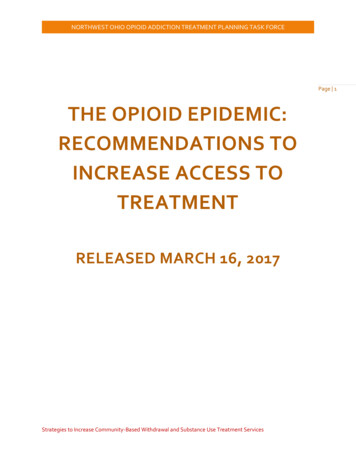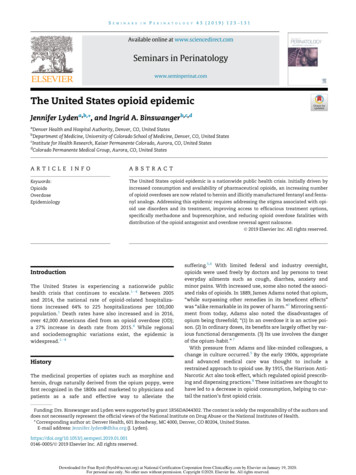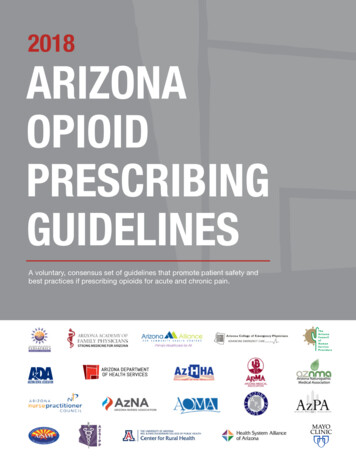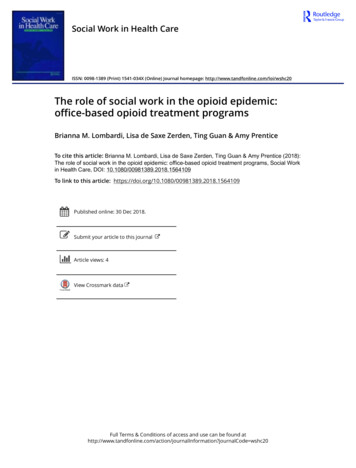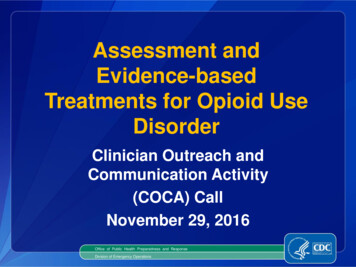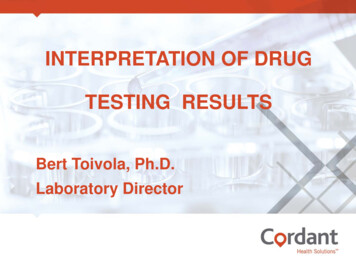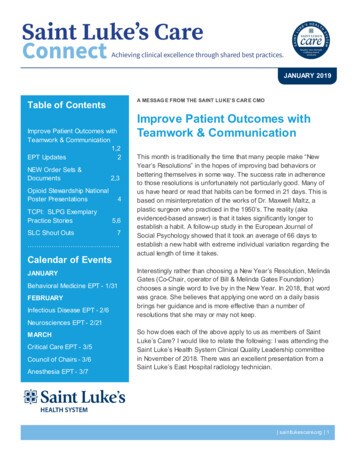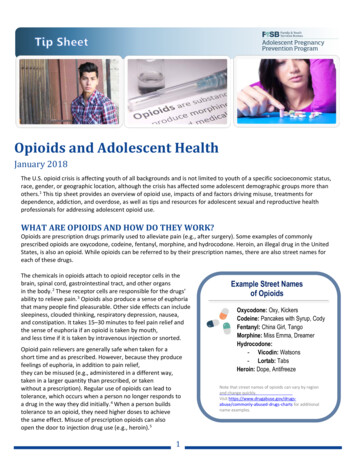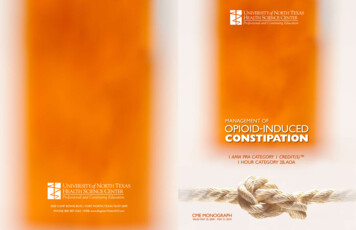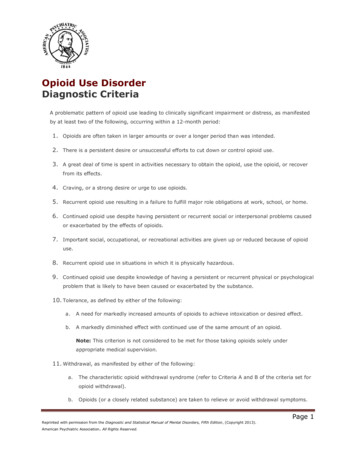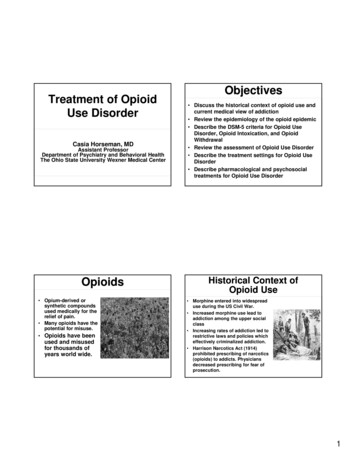
Transcription
Treatment of OpioidUse DisorderCasia Horseman, MDAssistant ProfessorDepartment of Psychiatry and Behavioral HealthThe Ohio State University Wexner Medical CenterOpioids Opium-derived orsynthetic compoundsused medically for therelief of pain. Many opioids have thepotential for misuse. Opioids have beenused and misusedfor thousands ofyears world wide.Objectives Discuss the historical context of opioid use andcurrent medical view of addiction Review the epidemiology of the opioid epidemic Describe the DSM-5 criteria for Opioid UseDisorder, Opioid Intoxication, and OpioidWithdrawal Review the assessment of Opioid Use Disorder Describe the treatment settings for Opioid UseDisorder Describe pharmacological and psychosocialtreatments for Opioid Use DisorderHistorical Context ofOpioid Use Morphine entered into widespreaduse during the US Civil War. Increased morphine use lead toaddiction among the upper socialclass Increasing rates of addiction led torestrictive laws and policies whicheffectively criminalized addiction. Harrison Narcotics Act (1914)prohibited prescribing of narcotics(opioids) to addicts. Physiciansdecreased prescribing for fear ofprosecution.1
Culture Change 1990s-2000sOpioid prescriptions per 100 peopleby state 2016 Strong emphasis on treatment of pain Widespread belief that those with pain were lesslikely to abuse opioids New potent opioids developed and aggressivelymarketed Supply of opioids increased markedly Pain Management Standards became effectiveJan. 1, 2001, via the Joint Commission Simultaneously, the rates of addiction to opioidsand death rates due to overdose also increased 64.164.1-82.983.0-107.1 107.1Source: CDCAddictionDefinition of Addiction Non-specific term frequently used to referto a variety of substance-related disorders& compulsive behaviors Not just physiological dependence Present when there is a pattern ofpathologic use A pattern of behavior with social,occupational, and interpersonalconsequences“Addiction is a primary, chronic disease of brain reward,motivation, memory and related circuitry. Dysfunction inthese circuits leads to characteristic biological,psychological, social and spiritual manifestations. This isreflected in an individual pathologically pursuing rewardand/or relief by substance use and other behaviors. It ischaracterized by inability to consistently abstain, impairmentin behavioral control, craving, diminished recognition ofsignificant problems with one’s behaviors and interpersonalrelationships, and a dysfunctional emotional response. Likeother chronic diseases, addiction often involves cycles ofrelapse and remission. Without treatment or engagement inrecovery activities, addiction is progressive and can result indisability or premature death.”American Society of Addiction Medicine, 20112
DSM-5 Opioid Use Disorder CriteriaA. A problematic pattern of opioid use leading toclinically significant impairment or distress, asmanifested by at least two of the following,occurring within a 12-month period:1. Opioids are often taken in larger amounts or over alonger period than was intended.2. There is a persistent desire or unsuccessful efforts tocut down or control opioid use.3. A great deal of time is spent in activities necessary toobtain the opioid, use the opioid, or recover from itseffects.4. Craving, or a strong desire or urge to use opioids.DSM-5 Opioid UseDisorder Criteria10. Tolerance, as defined by either of the following:a. A need for markedly increased amounts of opioids toachieve intoxication or desired effect.b. A markedly diminished effect with continued use ofthe same amount of an opioid.11. Withdrawal, as manifested by either of the following:a. The characteristic opioid withdrawal syndrome.b. Opioids (or a closely related substance) is taken torelieve or avoid withdrawal symptoms.DSM-5 Opioid Use Disorder Criteria5. Recurrent opioid use resulting in a failure to fulfillmajor role obligations at work, school, or home.6. Continued opioid use despite having persistent orrecurrent social or interpersonal problems caused orexacerbated by the effects of opioids.7. Important social, occupational, or recreational activitiesare given up or reduced because of opioid use.8. Recurrent opioid use in situations in which it isphysically hazardous.9. Continued opioid use despite knowledge of having apersistent or recurrent physical or psychologicalproblem that is likely to have been caused orexacerbated by the substance.Notes Regarding theCriteria Criteria are grouped according to similar symptoms: Criteria 1-4: Impaired control Criteria 5-7: Social impairment Criteria 8-9: Risky use Criteria 10-11: Pharmacological criteria Symptoms of tolerance and withdrawal occurring duringappropriate medical treatment with prescribedmedications are specifically not counted whendiagnosing a substance use disorder. A substance use disorder can be correctly diagnosed forprescribed medication when there are other symptoms ofcompulsive, drug-seeking behavior3
DSM-5 OUD SpecifiersDSM-5 Opioid Intoxication Criteria In early remission 3-12 months without symptoms (exceptcraving) In sustained remission More than 12 months without symptoms(except craving) On maintenance therapy (includes agonists andantagonists) In a controlled environmentA. Recent use of an opioid.B. Clinically significant problematic behavioral orpsychological changes that developed during, orshortly after, opioid use.C. Pupillary constriction (or pupillary dilation due toanoxia from severe overdose) and one (or more)of the following signs or symptoms developingduring, or shortly after, opioid use:1. Drowsiness or coma.2. Slurred speech.3. Impairment in attention or memory.DSM-5 Opioid Intoxication CriteriaDSM-5 Opioid Withdrawal CriteriaD. The signs or symptoms are not attributable toanother medical condition and are not betterexplained by another mental disorder, includingintoxication with another substance.Specify if: With perceptual disturbances: Thisspecifier may be noted in the rare instance inwhich hallucinations with intact reality testing orauditory, visual, or tactile illusions occur in theabsence of a delirium.A. Presence of either of the following:A. Cessation of (or reduction in) opioid use thathas been heavy and prolonged (i.e., severalweeks or longer).B. Administration of an opioid antagonist after aperiod of opioid use.4
DSM-5 Opioid WithdrawalCriteriaB. Three (or more) of the following developing withinminutes to several days after Criterion A:1. Dysphoric mood.2. Nausea or vomiting.3. Muscle aches.4. Lacrimation or rhinorrhea.5. Pupillary dilation, piloerection, or sweating.6. Diarrhea.7. Yawning.8. Fever.9. Insomnia.Opioid Withdrawal Short-acting opioids (e.g., heroin,hydrocodone, oxycodone) Usually begins 6-12 hours after last dosePeaks at 36-72 hoursLasts about 5 daysPossible protracted withdrawal (PAWS) Opioids with longer half-lives (e.g.,methadone) longer period before withdrawal onset methadone: 24-48 hours longer period before peak withdrawalsymptoms occurDSM-5 Opioid WithdrawalCriteriaC. The signs or symptoms in Criterion B causeclinically significant distress or impairment insocial, occupational, or other important areas offunctioning.D. The signs or symptoms are not attributable toanother medical condition and are not betterexplained by another mental disorder, includingintoxication or withdrawal from anothersubstance.Opioid Withdrawal Opioid intoxication IS life-threatening Opioid withdrawal IS NOT life threatening,but is exceedingly uncomfortable If respiratory compromise or seizures Always consider use of other drugs and treatif needed Sedative hypnotic withdrawal can be lifethreatening5
SBIRTTreatment Objectives Establish & maintain therapeutic allianceAssess safety & clinical statusManage intoxication & withdrawalDevelop treatment planEducate patient re: substance usedisorders Motivate the patient to change Prevent relapse Reduce morbidity & sequelaeScreening Ask about substance use using openended questions Follow up on any positive responses withformal tool or more intensive interview Alcohol, Smoking, and SubstanceInvolved Screening Test (ASSIST) orNIDA-Modified ASSIST Drug Abuse Screening Test (DAST) Consider point of care testing Evidence-based practice to identify, reduce, and preventproblematic use, abuse, and dependence on substanceswhich can occur in any healthcare setting. Screening Assess for risky substance use behavior withstandardized screening tools. Brief Intervention Engage patient showing risky substance usebehaviors in a short conversation, providingfeedback and advice. Goal to increase insight and awareness of the risksas well as motivation toward behavioral change Referral to Treatment Provide a referral to brief therapy or additionaltreatment.Brief Intervention Goal can range from increasing awareness ofrisk to reducing or eliminating use Understanding Stages of Change Precontemplation, contemplation, determination,action, maintenance Patients are in different stages based on readiness ormotivation to change Interventions should be tailored accordingly Not a linear process Patients cycle through stages before masteringbehaviors they want to change Motivational Interviewing6
Brief Intervention FRAMES Method offer Feedbackemphasize personal Responsibilitygive Adviceprovide a Menu of optionsuse Empathysupport Self-efficacyMedical Interview Chief complaint Present illness Substances used, frequency, route,problems caused by use Medical history Conditions needing opioids—dental,back pain, post-surgical Psychiatric history History of overdose, suicide attemptsAssessment of Opioid UseDisorder Should be completed by a trained,licensed/certified professional Should display positive, non-confrontationalinteraction Longitudinal assessment, collateral information Always inquire about use of other drugs Frequency, duration of use, withdrawal Past treatment history (what helped, what didn’t) Level of insight and motivation (Stages ofchange)Medical Interview Medications (controlled drugs) Allergies Consider multiple allergies to nonnarcotic or controlled medications Family history Addiction, suicide, medicalcomplications (cirrhosis, hepatitis, etc.) Social history Legal issues, child protective services,other users of substances Review of systems Prescription Monitoring Program7
Lab AnalysisPhysical Findings Unexplained bruises and abrasionsFrequent traumaSlurred speechConstricted pupilsMemory deficitsTrack marksJaundiceMurmurs Opioids detected in blood, urine, saliva,and hair Increased mean corpuscular volume (MCV) Increased liver enzymes (GTT, SGOT,SGPT) Elevated triglycerides, HDL Elevated uric acid Drug screen/ blood alcohol concentration Hepatitis serology, HIV testing, etc.Urine Toxicology Screen Random Urine Toxicology Screening: Goldstandard Heroin is excreted in urine as morphine 6-monoacetyl morphine (6-MAM) detected for12 hours – evidence of recent heroin use Person receiving results should understandlimitations of testing Routine opiate screens may not detectmeperidine, oxycodone, fentanyl, tramadol,buprenorphine, methadone Poppy seeds contain trace amounts ofcodeine and morphine and can give positiveresult.Treatment Settings Inpatient HospitalizationResidential Treatment ProgramsPartial HospitalizationOutpatient Treatment Intensive Outpatient Programs Outpatient counseling Medication Assisted Treatment (MAT)8
Opioid Use DisorderTreatment Overview Acute and maintenance phases of treatment Medical detoxification (acute) Tapering the substance itself or by substitutingthen tapering a closely related substance Standardized scales to monitor withdrawal (COWS,OOWS) Risk of overdose with decrease in tolerancefollowing treatment Minimize relapse risks (maintenance) Relapse rates high (90%) following detoxificationwith no medication treatment Pharmacologic interventions - agonist orantagonist treatmentInpatient treatment Goal is to stabilize acute medical andpsychiatric crises Hospitalization with around the clockmedical management Most intensive level of care and usuallyshort duration Management of detoxification or othermedical or psychiatric crises Psychosocial interventions (acute andmaintenance)Candidates for InpatientTreatment Patients with Severe overdoses, severe respiratorydepression or coma Severe withdrawal syndromes complicated bymultiple drugs Withdrawal complicated by acute or chronicgeneral medical conditions Severe psychiatric comorbidity making thema danger to self or others History of nonresponse to less intensive formof treatmentDetoxification Treatment Goals Resolve medical and psychiatric problemsassociated with withdrawal Prevent the development of complications ofwithdrawal Stop the patient’s pattern of abusive substanceuse during and following detox Enhance factors which promote sobriety Minimize factors which detract from sobriety Engage the patient in formal rehabilitation Prevent the need for repeated detoxification9
Medical DetoxificationMedical Detoxification Non-opioid detoxification Opioid detoxification Stabilize on methadone and taper Must be done at narcotic treatment programs Could be done in emergency situation when patientis hospitalized for other urgent medical problem Stabilize on buprenorphine and taper Can be done inpatient or outpatient by a waiveredphysicianResidential Treatment Live-in facility with 24 hour supervision Goal is to offer stable, structured, therapeuticenvironment May offer medical monitoring for detoxification Can vary in whether they provide medicationassisted treatment Can range in duration from 28 days to months oryears Can range in intensity from self-containedtherapeutic communities to halfway houses Clonidine Alpha-2 adrenergic agonists suppressautonomic symptoms caused by opioidwithdrawal Limiting side effect is hypotension Ultra-rapid opioid withdrawal Deep sedation and administer opioidantagonist to provoke withdrawal Withdrawal reportedly resolves in 2-3 dayswith patient on full dose of antagonist(naltrexone) if patient completes treatment;high drop-out rate Risk of serious adverse events: aspirationpneumonia, renal failure, deathCandidates for ResidentialTreatment Patients who Do not meet criteria for hospitalization Lack social supports or motivation tomaintain sobriety as an outpatient Have lack of transportation as a barrier toattending outpatient levels of care Have unstable housing or a living situationthat hinders the ability to maintain sobriety10
Intensive Outpatient Treatment/PartialHospitalization 9-30 hours per week Ranges from 3 to 7 sessions per week (3-8hours per session) Frequency and duration generallytapered as patients display increasingstability Goal is to provide more structure andsupport than traditional outpatient care Generally is group treatmentOutpatient Treatment Least intensive level of care Less than 9 hours of scheduled attendanceper week Can include individual counseling, groupcounseling, family counseling, medicationmanagement visits Can be used for primary intervention orextended aftercareCandidates for PHP/IOP Patients who Can maintain sobriety without full timesupervision Have some social support but requireadditional structure Are early in treatment and could benefit fromintensive education Are transitioning from hospital or residentialsettingsCandidates for OutpatientTreatment Patients who Have appropriate support systemsHave adequate living arrangementsHave transportation to servicesHave motivation to regularly attendtreatment11
Medication AssistedTreatment Options Methadone Long acting mu agonist Buprenorphine Mu partial agonist/antagonist Kappa antagonist Naltrexone Mu antagonist Long acting injectable naltrexone (Vivitrol) Used monthly Use of a long acting medication in thesame class as the abused drug (once dailydosing) Prevention of Withdrawal Syndrome Lifestyle stabilization Improved health and nutritional statusDecrease in criminal behaviorEmploymentDecrease in injection drug use/shared needlesBuprenorphineMethadone Full opioid agonist. Highly regulated schedule II drug Only available through federallyapproved facilities. Daily doses initially. Slow titration to therapeutic dose. Can cause respiratory depression anddeath if increased too quickly or takenin overdose. Cardiac risk : QT prolongation Check ECG before initiating andafter 30 days Approved for use in pregnancyAgonist Treatment(CC BY 2.0)Department of ForeignAffairs and Trade Available by prescription. Only agonist medication approvedfor treatment of OUD in office basedsetting Prescribers are required to haveadditional training and specialwaiver Mixed opioid agonist-antagonist. Can precipitate withdrawal unlesspatients is already in moderatewithdrawal. Effectiveness may be limited in veryheavy opioid users Therapeutic dose usually reached in 2448 hours. Less risk of respiratory depression anddeath in overdose.(CC BY-SA 3.0)Author: Supertheman12
Buprenorphine Formulations Buprenorphine/naloxone Naloxone is a full antagonist (Narcan)- included sopatients cannot use IV Most common form is films or tablets for sublingualadministration (Suboxone, Zubsolv) Also available in buccal film (Bunavail) Buprenorphine Most common form is tablet for sublingualadministration (Subutex) Primarily used for pregnant patients Long acting monthly injection (Sublocade) Implant for up to 6 months recently approved(Probuphine)Antagonist Treatment Use of receptor blocker to block agonisteffects of a dose of opioid Prevent impulsive use of drug Consider compliance: works well inmotivated patientsNaltrexonePsychosocial Interventions Opioid receptor blocker Available in daily tablet or monthlyinjection (Vivitrol) Side effects: hepatotoxicity Monitor liver function tests every 3months Risk of overdose if ‘overcome’ naltrexone Presented in individual or group settings in alllevels of care Evidence based interventions: Cognitive behavioral therapy and otherbehavioral therapies Motivational enhancement therapy 12-Step facilitation Psychodynamic therapy Interpersonal therapy Self help manuals Case management Marital and family therapy13
Additional ConsiderationsRegarding TreatmentReferences1. Like other chronic medical illnesses, thereis no “one size fits all” treatment. Mutual aid groups (AA/NA) alone is notconsidered treatment Can be an important adjunct totreatment It is important to include patients’family/significant other if possible There is a significant treatment gap Only about 10% of people in need oftreatment receive it2.3.4.5.6.7.American Psychiatric Association. (2013). Diagnostic and statistical manual ofmental disorders (5th ed.). Arlington, VA: American Psychiatric Publishing.Center for Substance Abuse Treatment. Clinical Guidelines for the use ofBuprenorphine in the Treatment of Opioid Addiction. Treatment ImprovementProtocol (TIP) Series 40. DHHS Publication No. (SMA) 04-3939. Rockville, MD:Substance Abuse and Mental Health Services Administration, 2004.Center for Substance Abuse Treatment. A Guide to Substance Abuse Servicesfor Primary Care Physicians. Treatment Improvement Protocol (TIP) Series 24.DHHS Publication No. (SMA) 08-4075. Rockville, MD: Substance Abuse andMental Health Services Administration, 2008.Centers for Disease Control and Prevention. U.S. State Prescribing Rates, 2016[Map]. Retrieved April 20, 2018 016.html.Courtwright, David T. Dark Paradise: A History of Opiate Addiction in America.Cambridge, Mass: Harvard University Press, 2009.Lipari, R. N., Park-Lee, E., and Van Horn, S. America’s need for and receipt ofsubstance use treatment in 2015. The CBHSQ Report: September 29, 2016.Center for Behavioral Health Statistics and Quality, Substance Abuse andMental Health Services Administration, Rockville, MD.Ries, R. K., Fiellin, D. A., Miller, S. C., & Saitz, R. (2014). The ASAM principles ofaddiction medicine: Fifth edition. Wolters Kluwer Health Adis (ESP).14
2 Culture Change 1990s-2000s Strong emphasis on treatment of pain Widespread belief that those with pain were less likely to abuse opioids New potent opioids developed and aggressively marketed Supply of opioids increased markedly Pain Management Standards became effective Jan. 1, 2001, via the Joint Commission Simultaneously, the rates of addiction to opioids
